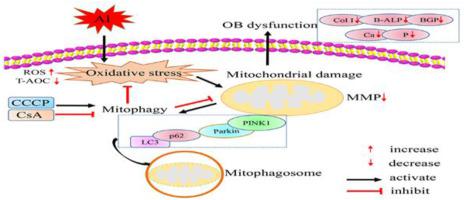Chemosphere ( IF 8.1 ) Pub Date : 2021-06-04 , DOI: 10.1016/j.chemosphere.2021.131086 Pengli Liu 1 , Yilong Cui 1 , Menglin Liu 1 , Bonan Xiao 1 , Jian Zhang 1 , Wanyue Huang 1 , Xuliang Zhang 1 , Miao Song 1 , Yanfei Li 1

|
Aluminum (Al) is a ubiquitous environmental metal toxicant that causes osteoblast (OB) damage which leads to Al-related bone diseases. Mitochondrial damage plays a key role in Al-related bone diseases, and while mitophagy can clear damaged mitochondria and improve OB function, the relationship between mitophagy and Al-induced OB dysfunction is unknown. To explore the role of mitophagy in Al-induced OB dysfunction in vitro, we used 2 μM carbonyl cyanide m-chlorophenylhydrazone (CCCP) and 0.4 μM Cyclosporin A (CsA) to activate and inhibit mitophagy, respectively. MC3T3-E1 cells were treated with 0 mM AlCl3 (control group); 2 mM AlCl3 (Al group); 2 μM CCCP (CCCP group); 2 μM CCCP and 2 mM AlCl3 (CCCP + Al group); 0.4 μM CsA (CsA group); 0.4 μM CsA and 2 mM AlCl3 (CsA + Al group). The results showed that Al induced ultrastructural and functional impairment of MC3T3-E1 cells. Compared to the Al group, mitophagy activation caused mitochondrial membrane potentials to collapse, up-regulated PINK1, Parkin, and LC3 expression, down-regulated p62 expression, and increased mitophagosome numbers. Mitophagy activation also reduced Al-induced oxidative stress and MC3T3-E1 cell functional damage, as seen in improvement in cell viability, cellular calcium and phosphorus contents, and collagen I, osteocalcin, and bone alkaline phosphatase gene expression. Mitophagy inhibition had the opposite effects on activation. Overall, these results show that mitophagy can protect against Al-induced OB dysfunction.
中文翻译:

线粒体自噬对铝诱导的 MC3T3-E1 细胞功能障碍的保护作用
铝 (Al) 是一种普遍存在的环境金属毒物,可导致成骨细胞 (OB) 损伤,从而导致与铝相关的骨病。线粒体损伤在铝相关骨病中起关键作用,虽然线粒体自噬可以清除受损线粒体并改善 OB 功能,但线粒体自噬与铝诱导的 OB 功能障碍之间的关系尚不清楚。为了探索线粒体自噬在 Al 诱导的体外OB 功能障碍中的作用,我们分别使用 2 μM 羰基氰化物间氯苯腙 (CCCP) 和 0.4 μM 环孢菌素 A (CsA) 来激活和抑制线粒体自噬。MC3T3-E1细胞用0mM AlCl 3 (对照组)处理;2 mM AlCl 3 (Al组);2 μM CCCP(CCCP 组);2 μM CCCP 和 2 mM AlCl 3(CCCP+铝组);0.4 μM CsA(CsA 组);0.4 μM CsA 和 2 mM AlCl 3(CsA + Al 组)。结果表明,铝诱导了 MC3T3-E1 细胞的超微结构和功能损伤。与 Al 组相比,线粒体自噬激活导致线粒体膜电位崩溃,上调 PINK1、Parkin 和 LC3 表达,下调 p62 表达,并增加线粒体自噬体数量。Mitophagy 激活还减少了铝诱导的氧化应激和 MC3T3-E1 细胞功能损伤,如细胞活力、细胞钙和磷含量以及胶原蛋白 I、骨钙素和骨碱性磷酸酶基因表达的改善所见。Mitophagy 抑制对激活有相反的影响。总的来说,这些结果表明线粒体自噬可以防止铝诱导的 OB 功能障碍。











































 京公网安备 11010802027423号
京公网安备 11010802027423号